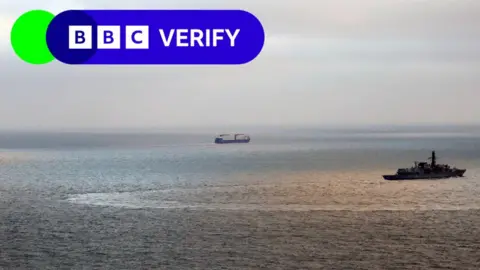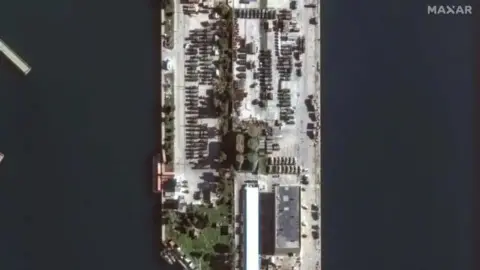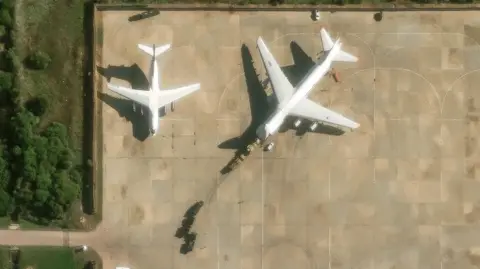Russian ships return to the Syrian territory of Tartous ahead of an expected withdrawal

BBC Confirm
 PA Media
PA MediaTwo Russian warships attached to its military have docked at the Kremlin’s military base on the Syrian coast in Tartous, and experts suggest the long-awaited evacuation of the facility has begun.
Sparta and Sparta II docked at Tartous on Tuesday. Both ships are sanctioned by the US and have been linked to Russian arms shipments by Ukraine.
Analysts had expected Russia to reduce its military presence in Syria following the fall of the Assad regime in December – which it supported during the civil war.
Dozens of military hardware have been moved to the port in recent weeks and have been seen in satellite images analyzed by BBC Verify.
The photo appears to show a number of cars and other objects sitting in the harbor. The hardware first appeared in mid-December following footage of large columns of Russian vehicles heading north towards the base – showing they had been redirected from other outposts across the country.
 Maxar
MaxarThe arrival of the ships coincides with reports in Syrian media that Russia’s lease of the port has been revoked. The new transitional government in Damascus refused to confirm the reports to the BBC, while Kremlin spokesman Dmitry Peskov also refused to comment when asked during a press conference in Moscow.
Tartous has become an important base for Russia in recent years, allowing it to refuel, supply and repair ships in the Mediterranean.
The Kremlin appeared determined to take control of the site, saying in December that Russian officials were talking to the new authorities about its continued presence.
Analysts suggested that Sparta and Sparta II – the latter owned by Oboronlogistika LLC – a shipping company operating as part of the Russian defense ministry, were denied permission to dock in Tartous while negotiations continued. The ships have spent several weeks off the coast of Syria in the Mediterranean Sea.
Marine tracking sites show the vessels finally stopped on Tuesday evening, after which they turned off their transponders.
The weather in recent days has made it difficult to get clear satellite images. But images from the EU’s Sentinel radar satellites – which have a low resolution but can penetrate below cloud cover – revealed that the ships were in the military section of the harbour.

Until now, no Russian warships had been seen in Tartous since the fall of the Assad regime in early December. In an earlier high-resolution satellite image, dozens of military vehicles could be seen parked near where the ships are now. And nearby were cranes that could be used to load cargo.
There may also be two more Russian warships in the port, military analyst Frederik Van Lokeren told BBC Verify. He said the ships, Ivan Gren and Alexander Otrakovsky, could also be involved in the exodus – sentiments echoed by Ukrainian military intelligence on BBC Verify.
“With the cancellation of the 49-year lease, it has become very clear to Russia that it can no longer hope to maintain a military presence in Tartous and therefore, there seems to be no need to stay there and delay the exit from the sea,” Mr Van Lokeren added.
The removal of all Russian assets may take some time, according to Anton Mardasov of the Middle East Institute’s Syria program.
“Over the years a lot has been delivered there with these ships and vessels,” Mr Mardasov told BBC Verify.
Meanwhile, there has been ongoing activity at Russia’s main airport in Syria, Hmeimim. Satellite images have shown large Russian jets being loaded with troops on various days since the fall of the Assad regime.
 Maxar
MaxarUkraine’s military intelligence service said Russian planes had transferred troops and equipment from Hmeimim to airfields in Libya at least 10 times since mid-December. The Kremlin already supports the warlord in Tobruk Khalifa Haftar in eastern Libya.
Moscow has long maintained a presence at two bases identified by Ukrainian intelligence – Al-Khadim and Al-Jufra. A former member of the UN military working group, Dr Sorcha MacLeod, told BBC Confirm that these facilities were previously owned by the Wagner Group.
He said the Russian Ministry of Defense has taken over the support of these bases through the new Africa Corps. Power is directly driven by Moscow and has took over most of the former role of the Wagner Group.
Dr Macleod added that the deployment of Russian troops to the country “makes sense given that Libya has become a major base of operations for the Africa Corps and access to West Africa”.
Additional reporting by Ned Davies and Joshua Cheetham. Photos by Mesut Ersoz.

Source link




